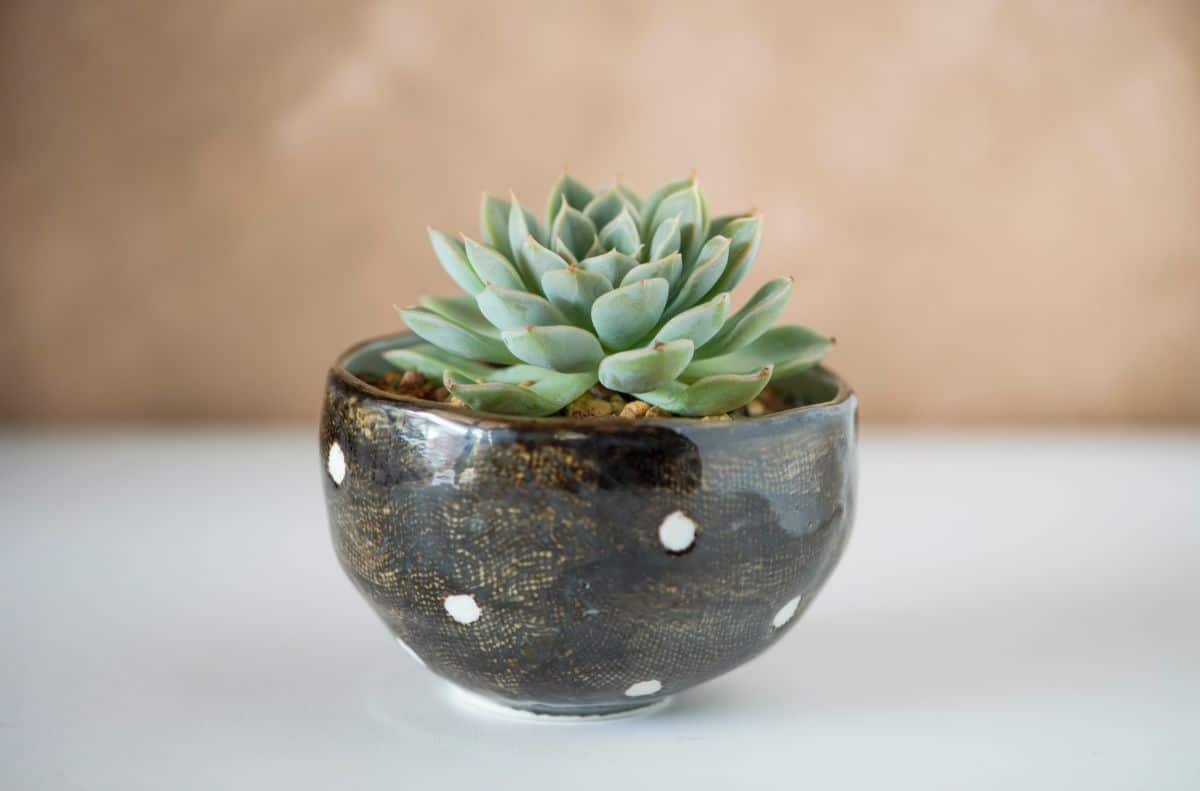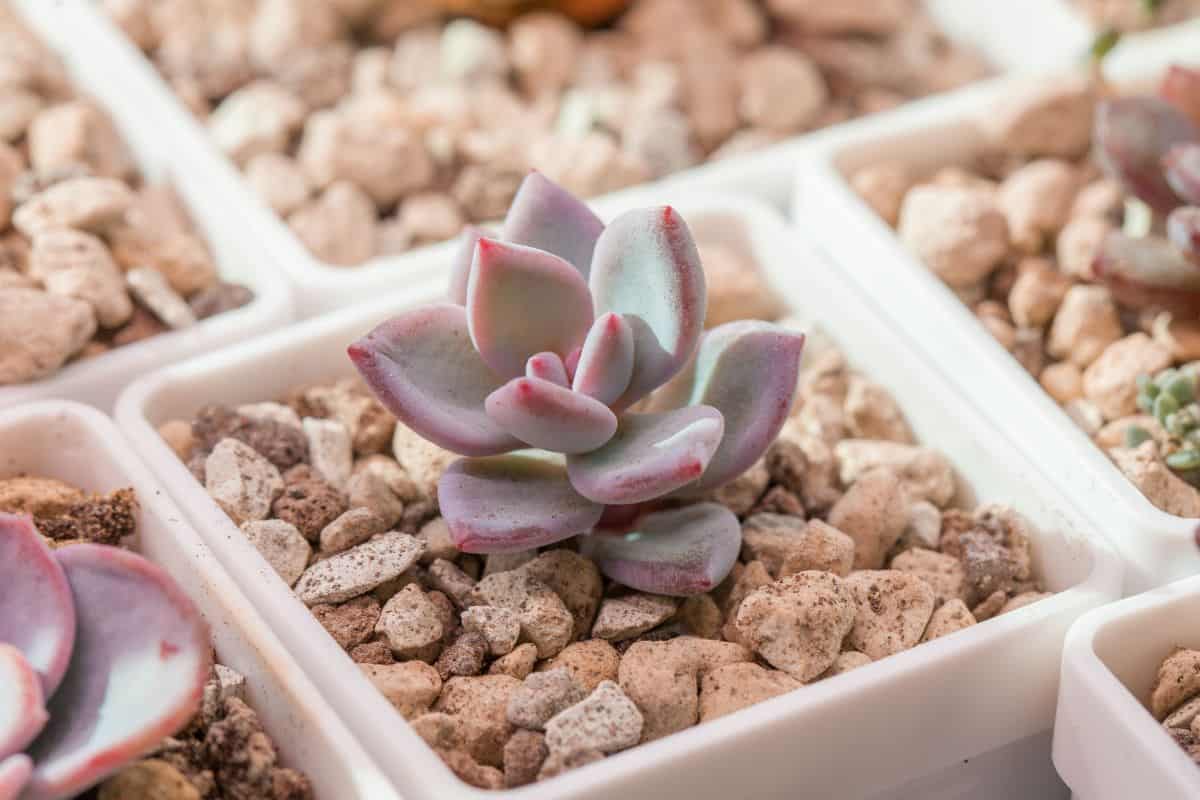
Echeveria cante is a very striking succulent. It forms a beautiful and neat rosette that looks eye-catching and dominant in any garden arrangement.
Succulents are notorious for being easy to care for, slow-growing, and unusual, but sometimes the less demanding plants with the most relaxed care turn out to be hard to manage. Don’t worry, this article will help you tackle all of the issues and hurdles associated with caring for low-maintenance plants.
This is the ultimate care guide for looking after echeveria cante succulents. By the end of this article, you will know how to care for your plant, what diseases and pests it is prone to, and how to propagate it. Enjoy!
Jump to:
Description
| Name: | Echeveria Cante |
| Soil: | Quick-drainingsoil |
| Blooming: | Summer |
| Light: | Minimum of six hours of sunlight per day |
| Water: | Once every week to ten days |
| Propagation: | Seed and leaf cuttings |
Most succulent species are a vibrant green color, but not this plant. The echeveria cante succulent is a soft greyish blue color with an almost powdery finish that glistens in the sunlight. The lavender-white coating covering the plant is actually a natural sun protector that the plant produces. Overhandling of the plant will remove the white powder and leave oily fingerprints on the leaves that will most likely stay on the plant for good.
The leaves have a soft rose pink edging, which makes them look even more spectacular from up close. These plants look fantastic grouped together in a garden container or in individual pots.
Mature and healthy plants can grow up to a foot long and one to two feet tall. Getting your plant to reach these sizes is rather difficult and may take a lot of time and practice as the plant needs to grow in optimal growing conditions.
Cultivars and Hybrids
You can cross-breed echeveria cante succulents to create hybrids; however, it is not a common practice for succulent hobbyist growers. Cultivars and hybrids are often propagated in the horticulture industry.
Care
Growing and caring for the ‘white cloud’ succulent is a pure delight. This succulent is very tolerant and easy to care for, so even inexperienced growers will be able to care for their plants successfully without worrying about sticking to a strict care routine.
Like with everything, you need to stick to some very basic growing rules so that your plant thrives and grows to its full potential. The following is a breakdown of the most important things to stick to when growing echeveria cante plants. If you stick within the guidelines described below, your plant should stay happy and healthy for a long time.
Light

Buy it from:
The light requirements for this plant vary depending on where you live. For those of you that are situated in coastal locations, you should let your plant bathe in sunlight for as long as possible. If you are situated inland or in desert-like regions, you should offer your plant partial shade.
Outdoor Plants
Keeping these plants in individual containers will make caring for them easier if you plan on keeping them outside. Doing this will give you the ability to move the plant around the garden to ensure it gets enough sunlight throughout the day and protect it by moving it near taller plants for some shade and protection during the strong noon sunlight.
No products found.
Indoor Plants
Finding a good spot for your indoor plant is tricky; after all, you want to put it in a location where you can see it and enjoy its beauty, but you also need to find a spot where it will get enough lighting. Placing it on a windowsill or in a sunroom to ensure it gets plenty of nourishment.

Water
Watering the echeveria cante is the trickiest thing to get right. Too much water and you run the risk of exposing your plant to root rot, whereas too little water will kill your plant.
The only way to measure whether your plant is getting the right amount of water is by keeping an eye on the soil’s moisture levels. You should only water the plant once the soil is dry, so as you can imagine, you might find yourself watering the plant every day in the summer and only once or twice every month in the winter.
Make it a priority to check the soil on a daily basis to prevent you from forgetting about the plant and failing to water it on time. If you don’t give your plant enough water, the root system will wither away. You might not notice this until it is too late, but if your plant is growing slower than usual and it is looking a bit dry and dehydrated, then you probably need to increase the amount of water it is getting.
Overwatered plants will begin to wilt, turn yellow or brown, and their firm leaves will all of a sudden start to go mushy and limp. These are all signs that the succulent is overwatered and may even have root rot.
When watering the succulent, water it from the base of the plant, as close to the soil as possible, and keep adding water until you see some draining through the pot. This should only be done once and repeated when the soil has dried out.
Temperature
Echeveria cante succulents are well known for their heat tolerance and hardiness. They are the perfect plants to keep in USA hardiness zones 9 to 11. Don’t worry if you live in a cooler climate, though; you can always grow your plant indoors to keep it protected from excess rain and frost.
This plant can survive through the hottest desert summers, but it isn’t too bad on its cold hardiness either. The echeveria cante will grow in 20°- 25° degrees Fahrenheit (-7°- -4° C) conditions as long as it is for a short period of time and its leaves don’t freeze over.
Humidity is the echeveria cante’s worst enemy. Exposure to humid conditions will cause your plant to wilt and show signs of overwatering due to the constant exposure to moisture.
Soil

You should plant echeveria cante plants in well-drained succulent or cactus soil. Avoid putting the plants in pre-fertilized soil as they don’t tolerate fertilizers very well.
It is best practice to re-pot new succulent plants in the soil of your choice. Garden centers and wholesalers often pot their plants in regular potting soil to save costs, so you don’t want to risk keeping the plant in soil that is not suitable for it for too long post-purchase.
Top Tip: If you feel like your plant could do with a boost, you can add a small amount of liquid fertilizer to the soil during its growing season to help it bloom.
Propagation
You can propagate your echeveria cante plant from leaf cuttings or seeds. Offsets very rarely grow from the mother plant, but if you do spot one, you should attempt to propagate it to stop it from interfering with the main plant.
Seeds
If you are up for a challenge and want to grow echeveria cante from seedlings, you will need to purchase high-quality seeds from a reputable retailer. Plant the seeds in soil with good drainage and water regularly until you start to see the plant. This should take about two weeks, and sometimes even longer.
Top Tip: Plant echeveria cante seeds in the spring if you want your seeds to germinate quickly.
Cuttings

Propagating succulents from leaf cuttings is very easy to do. Here is a step-by-step guide to propagating your plant using leaf cuttings:
1.Use a Sharp Sterilized Knife
Using a very sharp and sterilized knife, cut the leaf from the stem of the stem. Aim for a clean and sharp cut.
2. Leave it to Dry Out
Leave the leaf to callus over for a day or so before planting.
3. Plant
Put the leaf in succulent or cactus soil and water it regularly.
Offsets
If you are lucky enough to find an offset growing from the base of the mother plant, you can follow the instructions above to propagate it.
Common Pests and Problems
Succulents aren’t prone to many pests or diseases; however, there are a few things to look for. Powdery mildew and root rot are two conditions caused by overwatering your succulents. If you come across either of these problems, you should remove damaged parts of the roots and plant immediately.
Aphids and mealybugs are sometimes found around succulent plants. Inspect your succulents daily for signs of insect infestations, and use natural pesticides to treat the affected plant before the infestation becomes severe.
Top Tip: If you think that your plant may be damaged beyond repair, you should look for a healthy leaf or stem and attempt to propagate it. Make sure that there is no sign of disease on the part you wish to propagate to ensure the greatest chances of success.
Sources:


